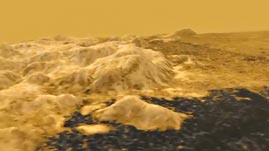Teachers' Domain - Digital Media for the Classroom and Professional Development
User: Preview

Source: NASA/JPL
Learn about the topography of Titan, one of Saturn's moons, in this interactive activity adapted from NASA. Videos and visualizations show how the geologic processes of Earth and Titan may be similar. Ontario Lacus, a lake made of liquid methane and ethane, has familiar shoreline features such as alluvial fans, flooded valleys, and deltas. Sikun Labyrinthus, is an area of karst topography where liquid has dissolved the rocks and produced a characteristic landscape of hills and valleys. Racetrack Playa, a dry lake bed in Death Valley, exhibits features that are comparable to those seen on Titan.
In the field of geology, uniformitarianism is a key concept that states that natural processes are constant though time and space. It asserts that the processes that occur now are the same processes that occurred in the past, and that the processes that operate on Earth also operate throughout the universe. Scientists can therefore apply knowledge learned from our own planet to study and interpret observations of other worlds.
For example, karst terrain on Earth has many distinctive and varied features such as sinkholes, caves, disappearing streams, valleys, rolling hills, and jagged peaks. Titan, the largest moon of Saturn, has many topographic features, including karst, that are analogous to features found on Earth. On Earth, karst landscapes are formed by the dissolution of soluble rocks (such as limestone or gypsum) by surface or ground water. Rainwater becomes mildly acidic when it reacts with the carbon dioxide in the atmosphere and soil. As the acidic water seeps through the rock, the water dissolves the rock, slowly increases the size of fractures, and carves out underground channels and caves. When enough rock is eroded away, landforms such as sinkholes and hills develop. There is karst terrain found in many different areas on Earth, including in tropical, temperate, and alpine regions.
The karst terrain observed on Titan was likely formed through a similar process, although the materials on Titan are different. Titan's average surface temperature is -179°C (-290°F); that is too cold for water to be in liquid form, which means that some other fluid—most likely a mixture of methane and ethane—must be responsible for creating Titan's karst landscape. On Earth, methane is known as natural gas and is found in large reservoirs underground and in the atmosphere. On Titan, methane and ethane are abundant and the temperature is right for them to exist as liquids. In fact, Titan likely maintains a methane cycle similar to the hydrologic cycle on Earth: liquid methane in rivers and lakes on the surface evaporates into the atmosphere where it cools and condenses to form clouds and precipitation, which then falls to the surface to continue the cycle. Despite the different materials, scientists can apply understanding of geologic processes on Earth to interpret their observations of Titan.
Because Titan is the only object in the solar system (other than Earth) known to have liquid on its surface, it can serve as a model for a young, cold earth. In addition, because life needs a liquid to survive, some people think that Titan is the most important place to look for extraterrestrial life. However, because the conditions there are so different than on Earth, if life did exist there, it would be completely different from life as we know it.
Here are suggested ways to engage students with this interactive and with activities related to this topic.
 Loading Standards
Loading Standards